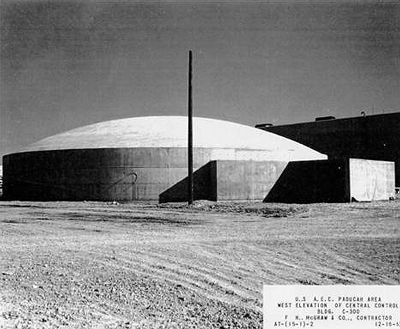PGDP History
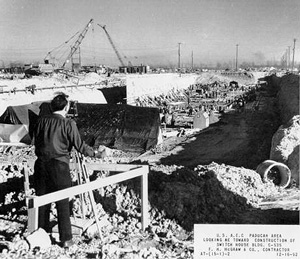
Past Influences the Future
The Paducah Gaseous Diffusion Plant (PGDP) has a rich and controversial history. In order to address the challenges facing the Plant’s cleanup, it is necessary to be aware of the Plant’s history.
Although the Plant was originally constructed to enrich uranium for warfare, the PGDP currently enriches uranium for nuclear power plants and employs approximately 1,200 workers.
One can only speculate about the future, but the likely plant closing will have a considerably negative impact on the local economy.
Kentucky Ordinance Works
On April 8, 1942, approximately 4 months after the attack on Pearl Harbor, an estimated 250 McCracken County families were given notice that they had to move in 10 days. The U.S. Army Corps of Engineers acquired 16,100 acres for the construction of a $30,000,000 Arms Plant.
The Kentucky Ordinance Works (KOW) was completed on April 30, 1943, including its own infrastructure, water and sewer system, power plant, hospital, laundry, roads and railroad. Operated by the Atlas Powder Company, the KOW was the largest of eleven (11) TNT plants in the U.S. and produced approximately 196,000 tons of TNT.
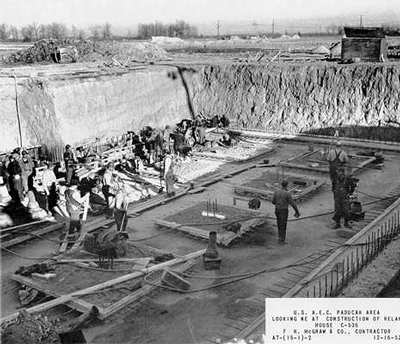
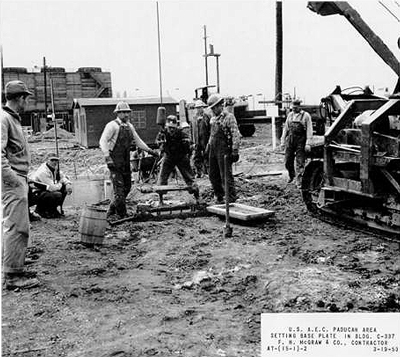
KOW Legacy
Immediately after the war, September 1945, the KOW was closed.
Only part of the original acquisition was safe enough for public use and was sold. The TNT production sites remained uninhabitable due to the possibility of explosion.
The Army Corps of Engineers accepts responsibility for cleanup of these sites. https://www.usace.army.mil/Missions/Environmental/
Cold War
On August 1, 1946, Congress established with the Atomic Energy Act of 1946 giving civilian control over atomic energy. That independent agency was the Atomic Energy Commission (AEC).
After the war, the fear of communism fueled the Cold War and Vice President Alban Barkley, a Paducah native, campaigned for the construction of a new uranium enrichment facility at the former KOW location.
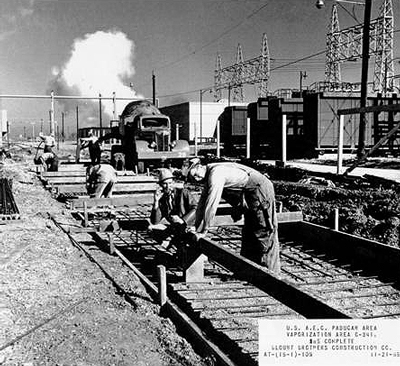
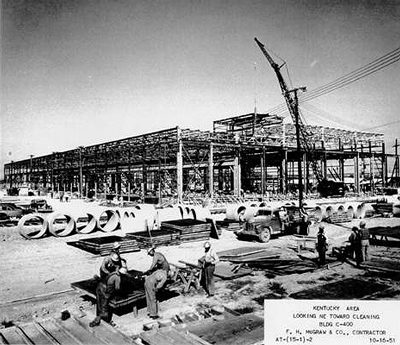
1950-1952 Paducah Site Chosen & Production Begins
In October 1950, the KOW site was chosen for the $800 million project. Additional acreage was acquired for a total of 3,425 acres (more recent surveys state 3,556 acres).
The Paducah Gaseous Diffusion Plant began production in September 1952.
F.H. McGraw and Co. of Hartford, Connecticut, was awarded the construction contract while Carbide and Carbon Chemicals Co. latterly named Union Carbide Chemical Company was the operating contractor.
Plant Security
The Plant lies within a 750 acre secure compound and of the remaining acreage, currently the Kentucky Fish and Wildlife leases the 1,986 acres for the West Kentucky State Wildlife Management Area.
For a comprehensive view of the surrounding area download the Kentucky Departmet of Fish & Wildlife map
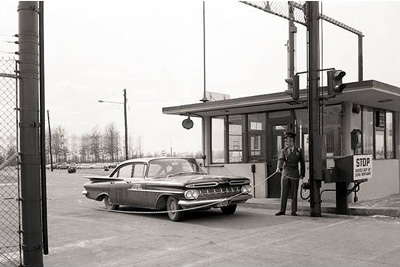
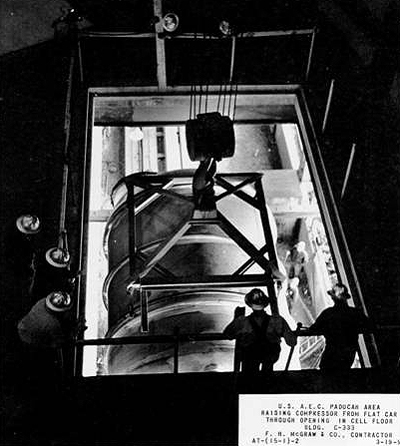
Shift from Military to Commercial Purpose
The Atomic Energy Act Amendment of 1954 allowed for the development of commercial nuclear power.
In 1965, the Paducah Gaseous Diffusion Plant (PGDP) switched from enriching uranium for bombs to enriching uranium for nuclear reactors.
End of the AEC
In 1975, the Nuclear Regulatory Commission (NRC) and the Energy Research and Development Administration (ERDA) took over the responsibilities for the Atomic Energy Commission (AEC). The ERDA assumed responsibilities for uranium enrichment.
Then in October 1977, the ERDA’s functions were transferred to the newly created Department of Energy (DOE).
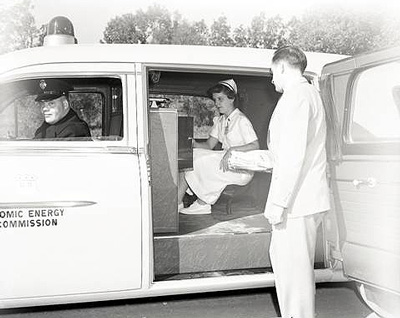
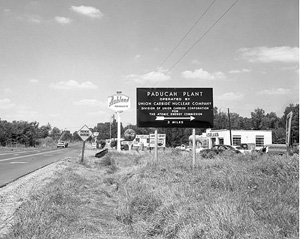
1984 Under New Management
After more than three decades, Union Carbide was replaced by Martin Marietta to operate the PGDP.
1987 Environmental Survey
The DOE preformed a baseline environmental survey revealing 93 potentially contaminated sites, three showed groundwater contamination.
Contamination outside the PGDP
On July 25, 1988, the McCracken County Health Department collected samples of private drinking-water wells; the Kentucky Cabinet for Human Resources (CHR) Radiation Control Branch (RCB) discovered Technetium-99 (99Tc) in wells northwest of the PGDP.
On August 10, 1988, Martin Marietta sampled wells around the perimeter of PGDP; 4 of the 12 wells contaminated with Trichloroethene (TCE) and 99Tc were residential.
On August 12, 1988, affected residents were told not to drink or bathe in the water; potable water was supplied.
On September 23, 1988, a contract was awarded to construct a water line extension to the affected residents.
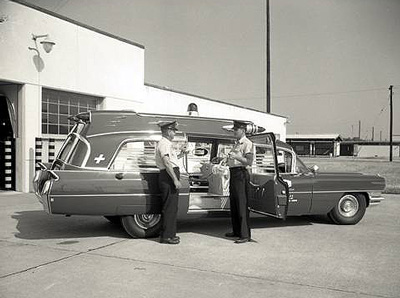
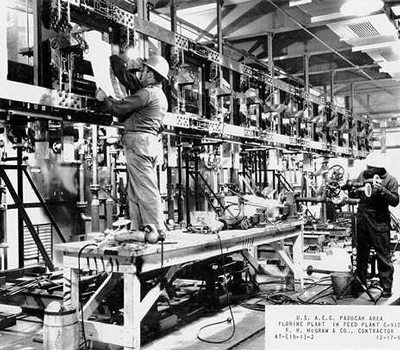
EPA and DOE
On November 23, 1988, the U.S. Environmental Protection Agency (EPA) and the DOE entered into an Administrative Order by Consent (AOC)
The ACO required the DOE to investigate and address the nature and extent of the PGDP-related contamination and its impacts on human health and the environment.
On August 19, 1991 Kentucky issued the DOE a Resource Conservation Recovery Act (RCRA) permit for the treatment and storage of hazardous PGDP wastes. The RCRA permit requires DOE to comply with environmental laws and regulations in the cradle to grave management of hazardous wastes, worker safety, record keeping, emergency planning and prevention, and protection of public health and the environment.
1993-1997, USEC & EPA
In 1993, the United States Enrichment Corporation (USEC) was created as a government corporation to restructure the enrichment operation but maintained Martin Marietta as a subcontractor.
On May 31, 1994, the PGDP was placed on the >National Priorities List (NPL). The NPL is part of the Superfund program, a U.S. environmental policy established by the Comprehensive Environmental Response, Compensation, and Liability Act (CERCLA) and regulated by the Resource Conservation and Recovery Act (RCRA).
In 1997, USEC became a private corporation and in 1998, USEC assumed control of the PGDP enrichment operations.
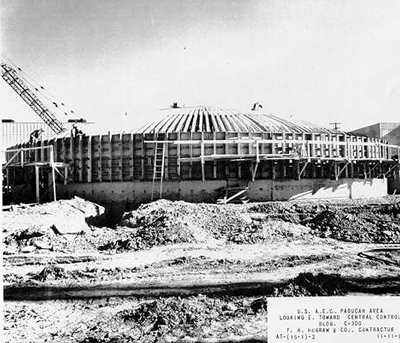
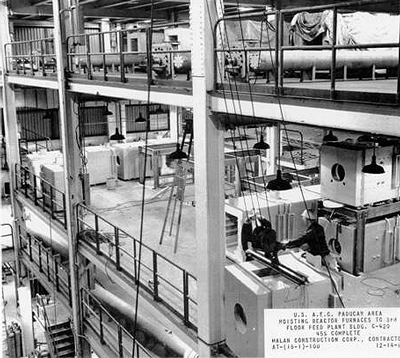
DOE, EPA, and Kentucky
In 1998, after 4 years of negotiations, the DOE, EPA, and the Commonwealth formally signed a PGDP Federal Facilities Agreement (FFA).
When a site is listed on the NPL and becomes a Superfund site, federal law requires that responsible state and federal agencies enter into a Federal Facilities Agreement (FFA). The FFA outlines the roles and responsibilities of the responsible agencies for the investigation and implementation of corrective measures at the facility and integrates state and federal cleanup requirements into an effective and comprehensive process.
In 2003, DOE signed an Agreed Order with Kentucky documenting formal commitments for cleanup and to settle outstanding enforcement and compliance.
Commitment to Cleanup
On September 15, 2003 the Kentucky Research Consortium for Energy and Environment (KRCEE) was established at the University of Kentucky for the purpose of supporting expeditious, cost effective, and technically effective environmental clean-up activities at the PGDP.
The PGDP is currently in transition from operation to cleanup. The plant is currently re-enriching spent uranium tails, disposing of legacy waste, deactivating and decommissioning, and demolishing inactive buildings.
According to the DOE, Office of Environmental Management, the current end state completion baseline date for Paducah is 2030.
source: “Paducah Gaseous Diffusion Plant”. February 2, 2012. DOE, Office of Environmental Management. https://www.energy.gov/pppo/paducah-site
